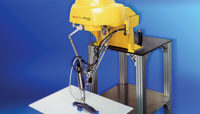However, Rosie the Riveter of World War II fame was a fictional person. Thanks to a classic Norman Rockwell cover on the Saturday Evening Post, Rosie became a household icon.
While Rosie wasn't an actual person, two lesser known riveting legends were real: James Kilroy and John Moir.
Remarkable Riveting Record
During World War I, Belfast, Ireland, was a major shipbuilding center. Local shipyards such as Harland and Wolff Ltd. (the company that built the Titanic, as well as other famous ocean liners) and Workman, Clark and Co. Ltd. constructed numerous battleships, destroyers and other large vessels.To increase production rates and boost morale, the companies created a special riveting competition among their assemblers. Numerous records were set and then broken. But, John Moir eclipsed them all.
On June 5, 1918, Moir drove 11,209 7/8-inch rivets into the double-bottom floor of a ship during a 9-hour shift. In the seventh hour, Moir shattered his own one-hour world record of the previous week by driving in 1,409 rivets--average of 23.5 rivets per minute. In his best minute, he drove in 26 rivets.
Moir beat his closest rival, John Lowry of Harland and Wolff, by more than 4,000 rivets! For his remarkable achievement, Moir's company presented him with a special £50 check as a prize. Moir's endeavor also earned him widespread fame and respect--he received telegrams from numerous dignitaries, including King George V and Prime Minister Lloyd George.
Kilroy Was There!
James Kilroy worked in a shipyard in Quincy, MA, during World War II. He was responsible for checking and recording the number of rivets that were driven by workers. It was an important job, because the riveters were paid by the rivet.At first, Kilroy counted a block of rivets and uses a chalk check mark to indicate that the block had been checked so the rivets wouldn't be counted twice. However, some riveters would erase the chalk mark when Kilroy went off duty. When a new checker came along, it would get counted twice and the riveters would end up getting paid twice.
When management discovered a payroll discrepancy, Kilroy was ordered to investigate. After he discovered what the riveters were doing, Kilroy started writing "Kilroy Was Here" in large crayoned letters.
Under normal circumstances, Kilroy's lettering would have been painted over. However, as the war dragged on, ships were being built and sent into battle so quickly that there wasn't any time for painting.
Millions of servicemen saw Kilroy's "graffiti" and began scrawling his slogan wherever they landed, claiming it was already there when they arrived. As a result, Kilroy suddenly became the "super GI" who always managed to be one step ahead. "Kilroy Was Here" became a secret code and friendly reminder indicating that Allied forces were nearby. It became a challenge to place the slogan in every place imaginable. People claim to have seen it in some unusual places, such as on top of Mt. Everest and on the moon. At the Potsdam Conference that marked the end of World War II, a special outhouse was built for the exclusive use of Churchill, Roosevelt and Stalin. The first person to use it was Stalin, who emerged and promptly asked one of his aids, "Who is Kilroy?"
In 1946, the Transit Company of America held a contest to discover the "real" Kilroy. More than 35 men stepped forward, but James Kilroy brought along officials from the shipyard and some of the riveters to prove his authenticity. Kilroy was awarded a trolley car, which he placed in his yard as a playhouse for his nine children.
To Rivet or Not to Rivet?
In his famous play, "King Henry the Fourth," William Shakespeare had this to say about rivets:The hum of either army stilly sounds,
That the fixed sentinels almost receive
The secret whispers of each other's watch:
Fire answers fire, and through their paly flames
Each battle sees the other's umbered face:
Steed threatens steed, in high and boastful neighs
Piercing the night's dull ear; and from the tents
The armorers, accomplishing the knights,
With busy hammers closing rivets up,
Give dreadful note of preparation.


